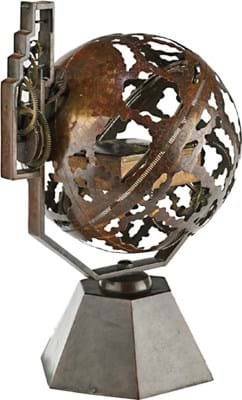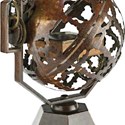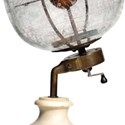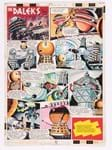The most expensive of them, by some distance, was a clockwork-driven Japanese celestial sphere that in a December 13 sale of works from the Givaudan family collections conducted by Swiss auction house Piguet (20% buyer’s premium). It sold for a much higher than predicted SwFr750,000 (£567,000) to a Hong Kong-based bidder.
Before the auction, the saleroom consulted a number of experts about its age and origins, notably Prof Christopher Cullen, whose 69pp report, along with a lengthy metallurgical study, were both made available to prospective bidders.
Piguet’s catalogue description reveals that the instrument stands a little over 2ft 1in (64cm) high and was made during the first half of the 17th century. It comprises “….two copper hemispheres meeting on the ecliptic as a belt of small slots gilded with the 24 solar seasons, the surface chased with cloud-like patterns, gilded characters and hexagrams with pierced decoration, revealing a box inside with a map representing the earth.
“In the internal ring the sun and moon sit on smaller toothed rings to rotate and be positioned according to the solar season, the axis supported by an external frame holding the verge and foliate escapement that enables the sphere to rotate once daily, following the apparent motion of the heavens.”
As seen above, the movement is mounted externally as part of the axis support frame and the sphere would have been displayed on a stand that allowed the weights a sufficient drop from the drum wheel.
The configuration of the sphere, said the saleroom, suggests that it was designed to be used at the latitude of Edo – modern Tokyo.
Remarkable survival
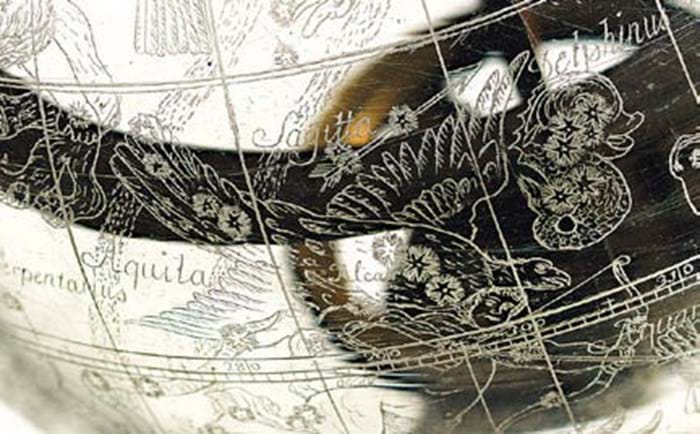
A detail of the engraved constellations on the 17th century English glass celestial globe by John Cowley sold by Christie’s at £130,000.
Sold for £130,000 by Christie’s (25/20/12.5% buyer’s premium) on the same day was a rare example of the English glass celestial globes produced by John Cowley for use with mechanical stands made by Thomas Heath. Another remarkable survival given its fragile nature, it is one of only three recorded examples.
Bearing the number 4 and signed and dated 1739 by Cowley, an example in London’s Science Museum was badly damaged at some stage and has a much later replacement inner terrestrial globe.
The other example, known as the Powderham Globe, is undated, but when sold by Christie’s some 30 years ago it was lotted with a terrestrial globe of c.1750 made by Nathaniel Hill.
Two earlier glass globes are recorded, but both are now lost. One was made for the Holy Roman Emperor, Charles V, by Mercator in 1552; the other is an example illustrated by Roger Long in his 1742 book on Astronomy…, where it is referred to as one he invented “above twenty years ago”.
Bearing an engraved cartouche that reads “J Cowley Londoni Sculpsit 1730”, the example sold recently in London has a thick, blown glass globe of 10in (25.5cm) diameter and slightly prolate form that is diamond engraved with the constellations and labelled in Latin.
An internal steel axis supports a terrestrial globe, brass horizon and meridian rings. The globe is supported on a later marble base rather than the original wooden one.
That base was probably added following its purchase in London in the early 19th century by a forebear of the Portuguese family who sent it to auction.
Family tradition has it that a great-great uncle went out with the intention of buying an aquarium, but returned instead with this glass globe, which at the time was full of dust and dirt.


